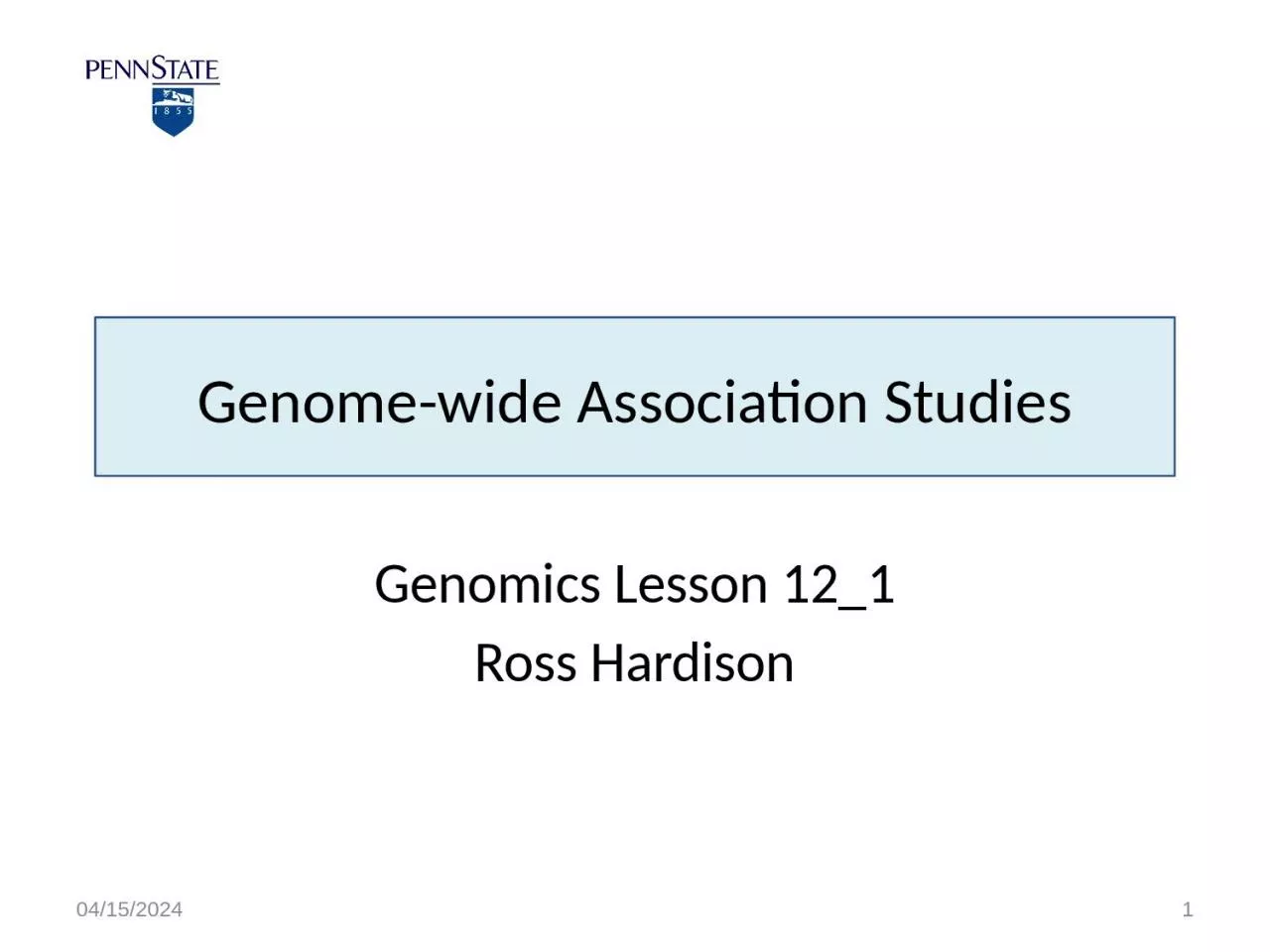

Genomics Lesson 121 Ross Hardison 41915 1 Genetic association The occurrence together in a population more often than can be readily explained by chance of two or more traits of which at least one is known to be genetic ID: 931936
Download Presentation The PPT/PDF document "Genome-wide Association Studies" is the property of its rightful owner. Permission is granted to download and print the materials on this web site for personal, non-commercial use only, and to display it on your personal computer provided you do not modify the materials and that you retain all copyright notices contained in the materials. By downloading content from our website, you accept the terms of this agreement.
Slide1
Genome-wide Association Studies
Genomics Lesson 12_1Ross Hardison
4/19/15
1
Slide2Genetic association
The occurrence together in a population, more often than can be readily explained by chance, of two or more traits of which at least one is known to be genetic.This can be between phenotypes, e.g. visible characteristics such as flower color or height, between a phenotype and a genetic polymorphism, such as a
single nucleotide polymorphism, between two genetic polymorphisms. Association between genetic polymorphisms occurs when there is non-random association of their alleles as a result of their proximity on the same chromosome; this is known as genetic linkage
.Wikipedia
4/19/15
2
Slide3Huntington Disease Pedigree
Vogel and
Motulsky
’s Human Genetics
, 4th edition,
Chpt
6, 2010.
haplotype
4/19/15
3
Slide4Mendelian traits and diseases: Can affect protein structure
Mutations that lead to Mendelian inheritance of traits or disease usually alter the function of single genes
Often reduce or modify the function of the protein product by changing the encoded amino acid sequenceHuntington Disease is caused by mutations in the gene HTT
Encodes huntingtinApparent role in neurons, but precise function unknown
Number of copies of a CAG repeat in the coding sequence
Normal: 10 to 35 copies of CAG
Disease-associated: 36 to >120 copies
Copy number between 36 and 39: may or may not develop symptoms
Copy number >= 40: almost always develop disorder
Genetics Home Reference
http://
ghr.nlm.nih.gov
/condition/
huntington
-disease
4/19/15
4
Slide5Variants in genes encoding Hb
4/19/155
Portion
o
f entries
Slide6Mendelian
traits and diseases: Can affect amount of proteinIn addition, some Mendelian diseases are caused by debilitating mutations in promoters or enhancers of a geneResults in a deficiency of the protein product and the consequent pathological
phenotypeE.g. beta-thalassemia
Giardine
et al. (2011) Nature Genetics
43
: 295-301
4/19/15
6
Slide7Mendelian variants: rare but with large effect size
Genetic variants causing Mendelian disease are rare in the human population because selective pressure against their deleterious effects keeps their allele frequency lowOne model for common (and complex) traits is that they are determined by common alleles of low effect size
Matthew W State & Pat Levitt (2011) The conundrums of understanding genetic risks for autism spectrum disorders. Nature Neuroscience 14, 1499–1506
4/19/15
7
Slide8Mapping variants causing Mendelian disease
Since the genetic variants causing monogenic diseases are rare, mapping studies are confined to detailed analyses of affected families and kindredsSuch studies have mapped genetic variants at the heart of many monogenic disorders
The Online Mendelian Inheritance in Man database currently lists almost 3400 phenotypes for which the molecular basis known. 4/19/15
8
Slide9Linkage analysis in
pedigrees for bipolar disorder
Vogel and
Motulsky
’
s
Human Genetics
, 4th edition,
Chpt
8, 2010.
4/19/15
9
Slide10SNPs are linked only over short distances
Vogel and
Motulsky
’s
Human Genetics
, 4th edition,
Chpt
8, 2010.
Can use association of a trait with many SNPs to get a high resolution map of determinants of a phenotype
4/19/15
10
Not
in a family
Slide11Genetics of susceptibilities to
common diseasesE.g. coronary artery disease, many forms of cancer and Type II diabetesHave substantial genetic
componentsThese phenotypes are affected by variants at multiple lociContrast to the Mendelian
diseasesThus susceptibility to a common disease is a complex
trait
Mapping
the multiple loci that contribute to these important traits usually follows a case-control design
(next slide)
The
mapping experiments examine single nucleotide polymorphisms (SNPs) to ascertain the genotypes that are significantly more prevalent in the affected group than in the
nonaffected
group
T
hese genotypes are associated with the trait of interestWhen genotypes are determined at SNPs throughout the genome of each individual, the study is called a
genome-wide association study, or GWAS.
4/19/15
11
Slide12Steps in GWAS
Vogel and
Motulsky
’
s
Human Genetics
, 4th edition,
Chpt
8.1, 2010.
Case Control
AA
AB
BB
Signal A
Signal B
4/19/15
12
Slide13Genetic association
Find SNPs with allele frequencies that differ significantly between groups
Hardison: JBC minireview
on Epigenetic data as guide to interpret GWAS
4/19/15
13
Slide14Common variants may be the main genetic determinants of complex traits
Genetic variants causing Mendelian disease are rare in the human population because selective pressure against their deleterious effects keeps their allele frequency
lowOne model for common (and complex) traits is that they are determined by common alleles But low effect sizeSmall phenotypic effect allows allele frequencies to increase to “common”, i.e. >=0.05
HapMap project greatly facilitated GWAS
Matthew W State & Pat Levitt (2011) The conundrums of understanding genetic risks for autism spectrum disorders. Nature Neuroscience 14, 1499–1506
4/19/15
14
Slide15GWAS results for 7 diseases
Vogel and
Motulsky
’
s
Human Genetics
, 4th edition,
Chpt
8, 2010.
4/19/15
15
Slide16http://www.genome.gov/GWAStudies/
Slide17Published Genome-Wide Associations through 12/2009,
658 published GWA at p
<
5x10
-
8
; in 2011: 1449 GWAS, 237 traits
NHGRI GWA Catalog
www.genome.gov/GWAStudies
Slide18Examples of cancer association studies